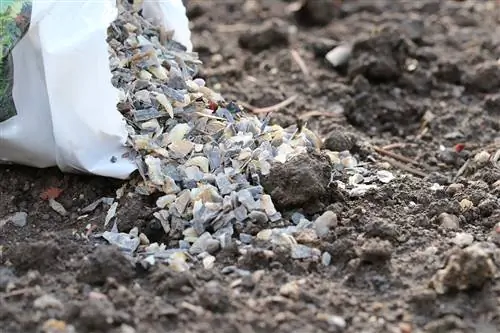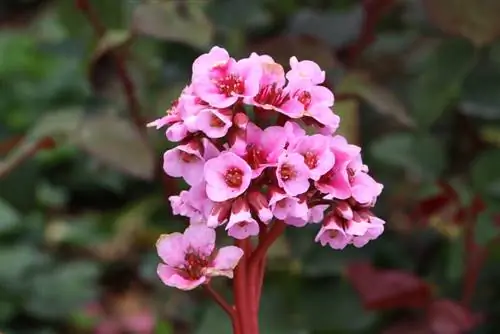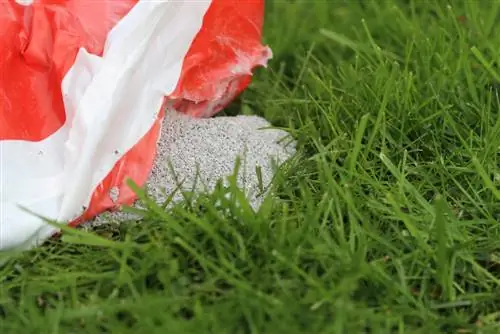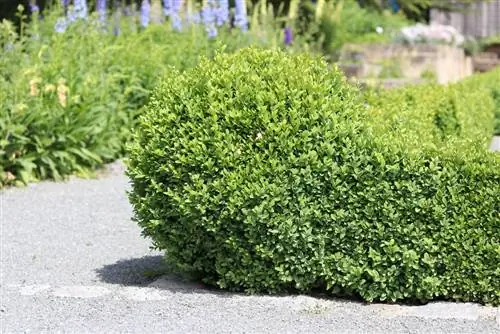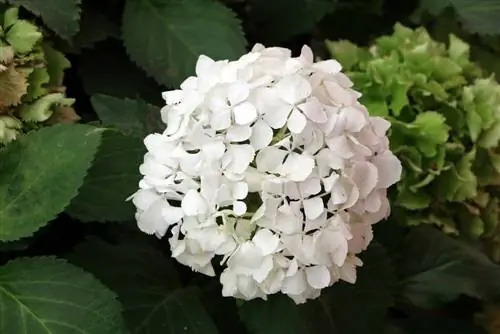- Author admin [email protected].
- Public 2023-12-17 03:39.
- Last modified 2025-06-01 06:48.
Plant fertilizer - what should you fertilize plants with? Lush green on the lawn, lush growth in the flower pots and outstanding, bright flowers - what hobby gardener doesn't want that? However, having a green thumb alone is not enough; fertilizers must be used to help.
However, make sure that not every fertilizer is equally suitable for every plant and the general motto here is: Less is often more!
Fertilizing is important for plants to thrive
For optimal growth, a plant needs nitrogen, magnesium, phosphorus and potassium. Nitrogen supplies the shoots and leaves and stimulates their growth, whereas phosphorus is responsible for root formation and also for the leaves. Potassium is an important factor in plant he alth and increases its resistance to pest and fungal attack. Potassium is also responsible for strengthening plant tissue, which protects the plant from a number of diseases. A rich coloring of the leaves can be achieved with magnesium. These important nutrients are contained in most complete fertilizers available on the market. Before fertilizing, however, you should keep in mind that not every fertilizer is equally suitable for every plant and often incorrectly fertilized plants can even die. It always depends on the plant needs, the soil conditions and the composition of the fertilizer.
It's all about the right dosage
The nutrient distribution of the fertilizer always depends on the soil condition. The dosage recommendation given on the packaging is always based on normal soil. Is the soil nutrient-rich, such as B. for clay soils, the dosage instructions can be reduced by half. In general, fertilize sparingly rather than over-fertilize. If a plant is over-fertilized, it will have many large leaves in a rich color, but will only develop a few flowers. For crops, this of course means a smaller harvest. In addition, the plants are then more susceptible to rain and wind. It is better to apply fertilizer more frequently with fewer fertilizers than to use a few applications with many fertilizers. A plant that requires a lot of light needs more fertilizer than plants that are predominantly in the shade. The best time of day to fertilize is early in the morning or generally when there is no sun.
Plants that are fertilized in sunshine run the risk of roots and leaves burning. This happens quickly when the soil is extremely dry. Plants generally only need fertilizers during the growth phase, i.e. when shoots or flowers form. In spring and summer, fertilization can be carried out from the beginning of budding until the shoots are finished. Exceptions are plants from humid tropical climates, which do not have a winter rest period. These should be fertilized all year round.
How do I determine the pH value of the soil?

The nutrient absorption of the soil depends on the pH value. Please note the following:
- a pH value between 5.5 and 6.5 is optimal for most useful or ornamental plants
- Nitrogen is best utilized by the plant at a pH value of 6.5 to 8.5
- Potassium is absorbed by plants at a pH of 6.5 to 7.5
- acidic soil does not require additional nitrogen fertilization
- alkaline soil does not require potassium fertilization
- You can test the soil condition with test strips that are available in garden shops
- If the soil is extremely acidic, i.e. below the pH value of 5.5, it absorbs nutrients poorly
- If the pH value is below 5.5, it should be enhanced with lime
- If the pH value is above 7, the soil should be treated with low-sulfur ammonia.
What fertilizer do you use?
Fertilizers and compost should only be added to the soil between March and early August, i.e. during the growing season. Later fertilization usually leads to further growth of the plants; they cannot become woody (mature). This causes the soft shoots to become sensitive to frost and many plants then die. It is best to fertilize outdoors with compost or organic-mineral fertilizer. This is particularly suitable for rhododendrons / ericaceous plants, roses / flowering trees and all lime-sensitive plants. The prices for this are between 2 and 5 euros per kilogram.
Container, potted or house plants can be fertilized either with blue grain or with liquid fertilizer. Liquid fertilizer, which is added to the irrigation water every 14 days, works quickly and is easy to dose and handle. All you have to do is follow the manufacturer's instructions and the soil should be pre-watered. You can even buy liquid fertilizer in the supermarket, where the price is around 1 euro per liter. Blaukorn should be used sparingly. Just place a few balls on the moistened soil at a distance of 1 to 2 cm and then water directly. The manufacturer's information must be particularly observed when it comes to Blaukorn and the price is between 5 and 7 euros for a 3 kg package. However, blue grain should never be used for regular, conventional fertilizing, as this artificial fertilizer can quickly burn the roots. In addition, blue grain is harmful to he alth in higher doses. Mineral fertilizers have the advantage that they work quickly due to their composition with nitrogen in the form of nitrate. However, outdoors should be mulched with organic, finely chopped waste (e.g. banana peels, coffee grounds) so that nutrient-rich humus is formed.
Optimal fertilization helps ensure that ornamental plants with rich colors thrive and show their full flowering splendor and that crops produce good yields, but the type and dosage of fertilizer depends on the soil conditions, the plant's needs, and… Place of planting (open ground, container or pot) and the composition and dosage of the fertilizer. The regular fertilization time is from March to the beginning of August and over-fertilization should be avoided.
What you should know about plant fertilizers in brief
Plants need plant fertilizer to grow, bloom and produce fruit. A distinction is made between main nutrients and trace elements: The main nutrients are nitrogen, phosphorus, potassium, calcium, magnesium and sulfur. Trace elements include iron, manganese, boron, zinc, copper and molybdenum.
- Nitrogen ensures he althy growth. It is particularly important for the formation of proteins that make up plant biomass. Phosphorus contributes significantly to root formation and the formation of flowers and fruits.
- Potassium regulates the water balance and all metabolic processes. It is needed so that the plant remains he althy and resilient.
- Calcium is needed for hair root formation and for the stability of the cell walls.
- Without magnesium there is no chlorophyll and therefore the plant cannot carry out photosynthesis.
- Sulfur is needed to form proteins. In some vegetables, sulfur is also part of the flavor.
- Iron deficiency is usually shown by yellowing of the leaves (chlorosis). Iron is required for chlorophyll formation.
- Manganese is needed for photosynthesis.
- Boron is important for the transport of carbohydrates and in the construction of cell walls.
- Zinc is necessary for the formation of carbohydrates and proteins.
- Without copper, the plant cannot convert nitrogen properly.
- Molybdenum is involved in the formation of enzymes that regulate the plant's metabolism.
The nutrients must be present in the right dose and in the right proportion. In nature, the nutrient balance is regulated alone. The dead plant parts rot and are converted back into nutrients by microorganisms. These can then be absorbed again by the plants. In the garden or even with houseplants, this cycle is interrupted by constant planting, harvesting and care. Regular fertilization returns all the main and trace nutrients to the soil and ensures optimal plant growth.
Mineral plant fertilizers
Mineral plant fertilizers (chemically produced) work very quickly. The nutrients are immediately available because they are in pure form. They do not have to be broken down by soil organisms first. In this way, deficiency symptoms can be eliminated quickly. However, you have to dose the mineral plant fertilizers very precisely, as there is a risk of burns or damage caused by overdosing if you overdose. The nutrients can also be washed out of the soil very easily.
Organic plant fertilizers
Organic plant fertilizers (naturally obtained) gently supply plants with nutrients and lead to a long-term improvement in the soil structure through the formation of natural, permanent humus. The nutrients are released slowly but very evenly with the participation of microorganisms and controlled by the temperature and soil moisture.
What is guano?
Guano is an organic plant fertilizer. It is particularly high quality. Guano consists of the excrement of seabirds. What is special is the unique combination of natural main nutrients, trace elements and other active ingredients. Guano has a mild and lasting fertilizing effect. The humic and growth substances contained activate the soil life and promote the root development of the plants. Organic-mineral plant fertilizers combine the advantages of the different groups. The mineral components work quickly and reliably against acute nutrient deficiencies. The organic components ensure a sustained supply of nutrients and ensure sustainable improvement of the soil.

More tips
Fertilization is mainly done with nutrients that cannot last long in the soil, such as phosphate, potassium and nitrogen. While potassium and phosphate can last for a relatively long time, there is a shortage of nitrogen quickly after fertilization. Because it is precisely this component that easily gets into the groundwater or is released into the air.
Plant fertilizers are available in different varieties, most of which differ in their composition. For example, there are organic and mineral fertilizers.
Organic fertilizer is usually obtained from natural sources. This includes stable manure, compost, bone meal, manure, etc. Mineral fertilizer is produced artificially so that the composition of the individual nutrients can be controlled.
Such fertilizers also contain nitrogen in an optimal amount, whereas with organic fertilizer it cannot be said exactly what proportion the mixture consists of. In addition, the nitrogen in organic fertilizer must first be released by microorganisms in order to be effective. This means it takes a little longer until the plant can access it. In contrast, they appear longer and more even. How quickly the release occurs also depends on whether the organic fertilizer is liquid or solid. Potassium and phosphate are sufficiently contained in both types of plant fertilizer.
Which fertilizer you ultimately choose depends entirely on your own preferences. Every fertilizer has its advantages and disadvantages. Before buying fertilizer, you should therefore determine exactly what needs the type of plant to be fertilized has. And the possible odor nuisance that may arise certainly plays a small role in making the right decision.

